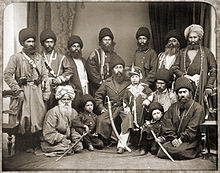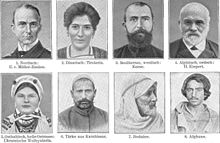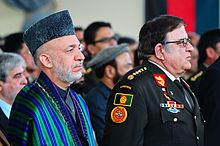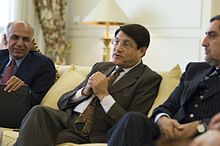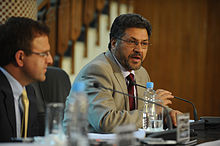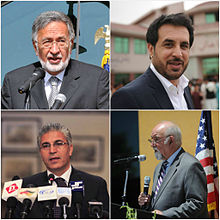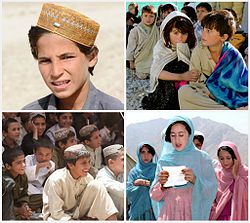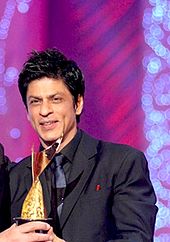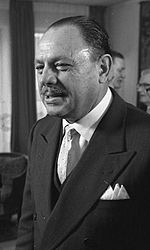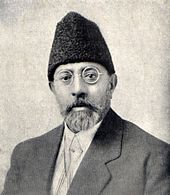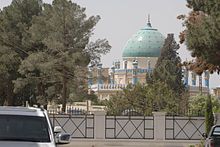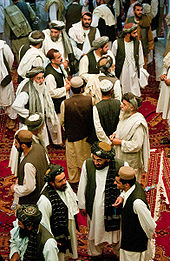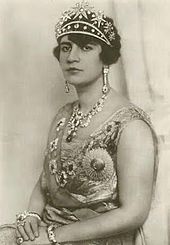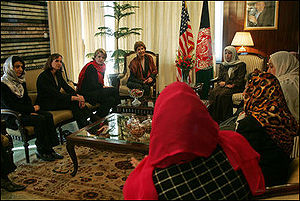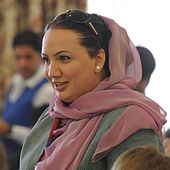
Pashtun people
Background to the schools Wikipedia
This Wikipedia selection is available offline from SOS Children for distribution in the developing world. Sponsoring children helps children in the developing world to learn too.
| 1st row: Ibrahim Lodi · Sher Shah Suri · Mirwais Hotak 2nd row: Ahmad Shah Durrani · Dost Mohammad Khan · Ayub Khan 3rd row: Abdur Rahman Khan · Amanullah Khan · Soraya Tarzi 4th row: Dost Mohammad Khan of Bhopal · Bacha Khan · Zahir Shah 5th row: Zalmay Khalilzad · Hamid Karzai · Shahid Afridi |
|||||||||||||||||||||||||||||||||||||||
| Total population | |||||||||||||||||||||||||||||||||||||||
|---|---|---|---|---|---|---|---|---|---|---|---|---|---|---|---|---|---|---|---|---|---|---|---|---|---|---|---|---|---|---|---|---|---|---|---|---|---|---|---|
| Approx. 50 million (2011) | |||||||||||||||||||||||||||||||||||||||
| Regions with significant populations | |||||||||||||||||||||||||||||||||||||||
|
|||||||||||||||||||||||||||||||||||||||
| Languages | |||||||||||||||||||||||||||||||||||||||
| Religion | |||||||||||||||||||||||||||||||||||||||
|
Islam ( Sunni Hanafi) |
|||||||||||||||||||||||||||||||||||||||
| Related ethnic groups | |||||||||||||||||||||||||||||||||||||||
|
Baloch, Hindkowans, Pashais, Nuristanis, Burushos, other Iranian peoples |
Pashtun people ( Pashto: پښتانه Pax̌tānə; also spelled Pushtun, Pakhtun or Pukhtun), also known as ethnic Afghans ( Persian: افغان) or Pathans (Urdu: پٹھان, Hindi: पठान Paṭhān), are an Iranic ethnic group belonging to Afghanistan and Pakistan. They are typically characterised by the usage of the Eastern Iranian Pashto language and practice of Pashtunwali, which is a traditional set of ethics guiding individual and communal conduct. Their origins are unclear but historians have come across references to various ancient peoples called Pakthas ( Pactyans) between the 2nd and the 1st millennium BC, inhabiting the region between the Hindu Kush and Indus River, who may be the early ancestors of the Pashtun people. Since the 3rd century AD onward, they have been referred to by the ethnonym " Afghan".
Often characterised as a warrior and martial race, their history is spread amongst various countries of South, Central and Western Asia, centred around their traditional seat of power in medieval Afghanistan. During the Delhi Sultanate era, the Pashtun Lodi dynasty replaced the Turkic rulers in the northern part of the Indian subcontinent. Other Pashtuns fought the Safavids and the Mughals before obtaining an independent state in the early-18th century, which began with a successful revolution by Mir Wais Hotak followed by conquests of Ahmad Shah Durrani. Pashtuns played a vital role during the Great Game from the 19th century to the 20th century as they were caught between the imperialist designs of the British and Russian empires.
Pashtuns are the largest ethnic group in Afghanistan and reigned as the dominant ethno-linguistic group for about 300 years, with nearly all rulers being Pashtun. The mujahideen who fought against the pro-Soviet Afghan government in the 1980s were also dominated by Pashtun fighters. Abdul Ahad Mohmand became the first Afghan and 4th Muslim to journey into outer space, spending nine days aboard Mir space station in 1988. Zalmay Khalizad became the first Muslim and first Afghan to become Ambassador of the United States. Many famous Bollywood superstars in India are of Pashtun descent. Some became high ranking officials working for the World Bank, the United Nations and other international organizations.
They made up the majority of the Taliban and the current Afghan government. They are also an important community in Pakistan, which has the largest Pashtun population and constitute the second-largest ethnic group, having attained presidency there and high rankings in sports. They are the world's largest (patriarchal) segmentary lineage ethnic group. According to Ethnologue, the total population of the group is estimated to be around 50 million but an accurate count remains elusive due to the lack of an official census in Afghanistan since 1979. Estimates of the number of Pashtun tribes and clans range from about 350 to over 400.
Geographic distribution
The vast majority of Pashtuns are found in the traditional Pashtun homeland, located in an area south of the Oxus River in Afghanistan and west of the Indus River in Pakistan, which includes Khyber-Pakhtunkhwa, Federally Administered Tribal Areas (FATA) and part of Balochistan. Additional Pashtun communities are located in western and northern Afghanistan, the Gilgit–Baltistan and Kashmir regions and northwestern Punjab province of Pakistan, as well as in the Khorasan province of Iran. There are also sizeable Muslim communities in India, which are of largely Pashtun ancestry. Throughout the Indian subcontinent, excluding Pashtun-dominated regions, they are often referred to as Pathans. Smaller Pashtun communities are found in the countries of the Arabian Peninsula, Europe and the Americas, particularly in North America.
Important metropolitan centres of Pashtun culture include Peshawar, Quetta, Kandahar, Jalalabad and Lashkar Gah. There are a number of smaller Pashtun dominated towns such as Swat, Khost, Asadabad, Gardēz, Farah, Pul-i-Alam, Mingora, Bannu, Parachinar, Swabi, Maidan Shar, Tarin Kowt and others. The cities of Kabul and Ghazni in Afghanistan are home to around 25% Pashtun population while Herat and Mazar-i-Sharif each has at least 10%. With as high as 7 million by some estimates, the city of Karachi in Sindh, Pakistan has the largest concentration of urban Pashtuns in the world. In addition, Rawalpindi, Islamabad, and Lahore also have sizeable Pashtun populations.
Pashtuns comprise over 15% of Pakistan's population. In Afghanistan, they make up an estimated 42% of the population according to the CIA World Factbook. Some sources give 50–60% because the exact figure remains uncertain in Afghanistan, and are affected by the 1.7 million Afghan refugees that remain in Pakistan, a majority of which are Pashtuns. Another 937,600 Afghans live in Iran according to the United Nations High Commissioner for Refugees (UNHCR). A cumulative population assessment suggests a total of around 49 million individuals all across the world.
History and origins
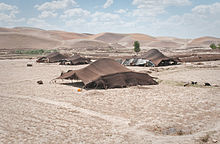
The history of the Pashtun people is ancient and much of it is not fully researched. Excavations of prehistoric sites suggest that early humans were living in what is now Afghanistan at least 50,000 years ago. Since the 2nd millennium BC, cities in the region now inhabited by Pashtuns have seen invasions and migrations, including by Ancient Iranian peoples, the Medes and Persians of antiquity, Greeks, Indians, Kushans, Hephthalites, Arabs, Turks, Mongols, and others. In recent age, people of the Western world have explored the area as well.
There are many conflicting theories about the origin of Pashtuns, some modern and others archaic, both among historians and the Pashtuns themselves. According to most historians, the true origin of the Pashtuns is some what unclear.
"...the origin of the Afghans is so obscure, that no one, even among the oldest and most clever of the tribe, can give satisfactory information on this point."
"Looking for the origin of Pashtuns and the Afghans is something like exploring the source of the Amazon. Is there one specific beginning? And are the Pashtuns originally identical with the Afghans? Although the Pashtuns nowadays constitute a clear ethnic group with their own language and culture, there is no evidence whatsoever that all modern Pashtuns share the same ethnic origin. In fact it is highly unlikely."
Early precursors to some of the Pashtuns may have been old Iranian tribes that spread throughout the eastern Iranian plateau. According to the Russian scholar Yu. V. Gankovsky, the Pashtuns probably began as a "union of largely East-Iranian tribes which became the initial ethnic stratum of the Pashtun ethnogenesis, dates from the middle of the first millennium CE and is connected with the dissolution of the Epthalites (White Huns) confederacy." He proposes Kushan-o-Ephthalite origin for Pashtuns but others draw a different conclusion. According to Abdul Hai Habibi some oriental scholars hold that the second largest Pasthun tribe, the Ghilzais, are the descendants of a mixed race of Hephthalite and Pakhtas who have been living in Afghanistan since the Vedic Aryan period.
They are intimately tied to the history of modern Afghanistan, Pakistan and northern India. Following Muslim conquests from the 7th to 11th centuries, many Pashtun ghazis (warriors) invaded and conquered much of the Indian subcontinent during the Ghaznavids, Ghurids, Khilji dynasty, Lodhi dynasty, Suri dynasty and others.
Anthropology and oral traditions
Some anthropologists lend credence to the oral traditions of the Pashtun tribes themselves. For example, according to the Encyclopaedia of Islam, the theory of Pashtun descent from Israelites is traced to Maghzan-e-Afghani who compiled a history for Khan-e-Jehan Lodhi in the reign of Mughal Emperor Jehangir in the 17th century. Another book that corresponds with Pashtun historical records, Taaqati-Nasiri, states that in the 7th century BC a people called the Bani Israel settled in the Ghor region of Afghanistan and from there began migrating southeast. These references to Bani Israel agree with the commonly held view by Pashtuns that when the twelve tribes of Israel were dispersed (see Israel and Judah), the tribe of Joseph, among other Hebrew tribes, settled in the Afghanistan region. This oral tradition is widespread among the Pashtun tribes. There have been many legends over the centuries of descent from the Ten Lost Tribes after groups converted to Christianity and Islam. Hence the tribal name Yusufzai in Pashto translates to the "son of Joseph". A similar story is told by many historians, including the 14th century Ibn Battuta and 16th century Ferishta.
One conflicting issue in the belief that the Pashtuns descend from the Israelites is that the Ten Lost Tribes were exiled by the ruler of Assyria, while Maghzan-e-Afghani says they were permitted by the ruler to go east to Afghanistan. This inconsistency can be explained by the fact that Persia acquired the lands of the ancient Assyrian Empire when it conquered the Empire of the Medes and Chaldean Babylonia, which had conquered Assyria decades earlier. But no ancient author mentions such a transfer of Israelites further east, or no ancient extra-Biblical texts refer to the Ten Lost Tribes at all.
Other Pashtun tribes claim descent from Arabs, including some claiming to be descendants of the Islamic prophet Muhammad (referred to as Sayyids). Some groups from Peshawar and Kandahar believe to be descended from Ancient Greeks that arrived with Alexander the Great. In terms of race, they are classified as Caucasians of the Mediterranean variant. Pashto language is classified under the Eastern Iranian sub-branch of the Iranian branch of the Indo-European family of languages. Those who speak a dialect of Pashto in the Kandahar region refer to themselves as Pashtuns, while those who speak a Peshawari dialect call themselves Pukhtuns. These native people compose the core of ethnic Pashtuns who are found in southeastern Afghanistan and western Pakistan. The Pashtuns have oral and written accounts of their family tree. The elders transfer the knowledge to the younger generation. Lineage is considered very important and is a vital consideration in marital business.
Modern era
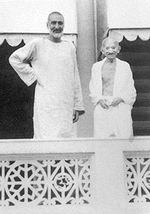
Their modern past stretches back to the Hotaki dynasty and the Durrani Empire. The Hotakis were Ghilzai tribesmen, who defeated the Persian Safavids and seized control over much of Persia from 1722 to 1738. This was followed by the conquests of Ahmad Shah Durrani who was a former high-ranking military commander under Nader Shah of Khorasan. He created the last Afghan empire that covered most of what is today Afghanistan, Pakistan, Kashmir, Indian Punjab, as well as the Kohistan and Khorasan provinces of Iran. After the decline of the Durrani dynasty in the first half of the 19th century under Shuja Shah Durrani, the Barakzai dynasty took control of the empire. Specifically, the Mohamedzai subclan held Afghanistan's monarchy from around 1826 to the end of Zahir Shah's reign in 1973. This legacy continues into modern times as the state is led by the Karzai administration under President Hamid Karzai, who is from the Popalzai tribe of Kandahar.
The Pashtuns in Afghanistan resisted British designs upon their territory and kept the Russians at bay during the so-called Great Game. By playing the two super powers against each other, Afghanistan remained an independent sovereign state and maintained some autonomy (see the Siege of Malakand). But during the reign of Abdur Rahman Khan (1880–1901), Pashtun regions were politically divided by the Durand Line, and what is today western Pakistan was claimed by British in 1893. In the 20th century, many politically active Pashtun leaders living under British rule of undivided India supported Indian independence, including Ashfaqulla Khan, Abdul Samad Khan Achakzai, Ajmal Khattak, Bacha Khan and his son Wali Khan (both members of the Khudai Khidmatgar, popularly referred to as the Surkh posh or "the Red shirts"), and were inspired by Mohandas Gandhi's non-violent method of resistance. Some Pashtuns also worked in the Muslim League to fight for an independent Pakistan, including Yusuf Khattak and Abdur Rab Nishtar who was a close associate of Muhammad Ali Jinnah.
The Pashtuns of Afghanistan attained complete independence from British political intervention during the reign of King Amanullah Khan, following the Third Anglo-Afghan War. By the 1950s a popular call for Pashtunistan began to be heard in Afghanistan and the new state of Pakistan. This led to bad relations between the two nations. The Afghan monarchy ended when President Daoud Khan seized control of Afghanistan from his cousin Zahir Shah in 1973, which opened doors for a proxy war by neighbors and the rise of Marxism. In April 1978, Daoud Khan was assassinted along with his family and relatives. Mujahideen commanders began being recruited in neighboring Pakistan for a guerrilla warfare against the Democratic Republic of Afghanistan. After the Iranian Revolution, deaths of Zulfikar Ali Bhutto and Nur Muhammad Taraki, the Soviet Union invaded its southern neighbour Afghanistan in December 1979 to help the Afghan government defeat a nationwide insurgency. The mujahideen were funded by the United States, Saudi Arabia and others, and included some Pashtun commanders such as Mullah Omar, Gulbuddin Hekmatyar and Jalaluddin Haqqani, who are currently waging an insurgency against the Islamic republic of Afghanistan and the US-led NATO forces. In the meantime, millions of Pashtuns fled their native land to live among other Afghan diaspora in Pakistan and Iran, and from there tens of thousands proceeded to North America, the European Union, the Middle East, Australia and other parts of the world.
In the late 1990s, Pashtuns became known for being the primary ethnic group that comprised the Taliban, which was a religious government based on Islamic sharia law formed to end the civil war. On the other hand, the Taliban opposition also included Pashtuns. Among them were Abdul Qadir and his brother Abdul Haq, Abdul Rasul Sayyaf, Gul Agha Sherzai, the Karzais, Abdullah Abdullah, Asadullah Khalid and many others. The Taliban were ousted in late 2001 during the US-led Operation Enduring Freedom and replaced with the current Karzai administration, which is dominated by Pashtun ministers.
Some of these include: Foreign Minister Zalmay Rasoul, Defense Minister Abdul Rahim Wardak, Finance Minister Omar Zakhilwal, Education Minister Ghulam Farooq Wardak, Commerce Minister Anwar ul-Haq Ahady, Agriculture Minister Mohammad Asef Rahimi and Communication Minister Amirzai Sangin. The list of current governors of Afghanistan, as well as the parliamentarians in the House of the People and House of Elders, include large percentage of Pashtuns. The Chief of staff of the Afghan National Army, Sher Mohammad Karimi, and Commander of the Afghan Air Force, Mohammad Dawran, as well as Chief Justice of Afghanistan Abdul Salam Azimi and Attorney General Mohammad Ishaq Aloko also belong to the Pashtun ethnic group. Several prominent Pashtun families include the Tarzis, Gilanis, and the Karzais.
They not only played an important role in South Asia but also in Central Asia and the Middle East. Many of the non-Pashtun groups in Afghanistan have adopted the Pashtun culture and use Pashto as a second language. For example, many leaders of non-Pashtun ethnic groups in Afghanistan practice Pashtunwali to some degree and are fluent in Pashto language. This includes non-Pashtun leaders such as Ahmad Shah Massoud, Ismail Khan, Mohammed Fahim, Bismillah Khan Mohammadi, Atta Muhammad Nur, Abdul Ali Mazari, Karim Khalili, Husn Banu Ghazanfar, Muhammad Yunus Nawandish, Abdul Karim Brahui, Jamaluddin Badr, and many others. The Afghan royal family, which was represented by King Zahir Shah, belongs to the Mohammadzai Pashtuns. Other prominent Pashtuns include the 17th-century poets Khushal Khan Khattak and Rahman Baba, and in contemporary era Afghan Astronaut Abdul Ahad Mohmand, former U.S. Ambassador to the United Nations Zalmay Khalilzad, Ashraf Ghani Ahmadzai, Ali Ahmad Jalali, Hedayat Amin Arsala and Mirwais Ahmadzai among many others.
Many ethnic Pashtuns of Pakistan have adopted non-Pashtun cultures and other languages such as Urdu. This includes Ayub Khan, Yahya Khan, and Ghulam Ishaq Khan, who attained the Presidency. Ghulam Mohammad became the Governor-General of Pakistan from 1951 to 1955. During the Ayub Khan administration (1959-1969), the capital of Pakistan was shifted from Karachi in Sindh to the new city of Islamabad, which is a separate administrative unit that sits next to Pakhtunkhwa (Pashtun area). Many more held high government posts, such as Army Chiefs Gul Hassan Khan and Abdul Waheed Kakar, Chairmen of the Joint Chiefs of Staff Rahimuddin Khan and Ehsan ul Haq, Interior Ministers Aftab Ahmad Sherpao and Naseerullah Babar, and so on. Others became famous in sports (i.e. Shahid Afridi, Imran Khan, Jahangir Khan, and Jansher Khan) and literature (i.e. Ghani Khan, Ameer Hamza Shinwari, Munir Niazi, and Omer Tarin). The Awami National Party (ANP) of Pakistan is represented by Asfandyar Wali Khan, grandson of Bacha Khan, while the chairman of the Pakhtunkhwa Milli Awami Party (PMAP) is Mahmood Khan Achakzai, son of Abdul Samad Khan Achakzai.
One of India's former presidents, Zakir Hussain, had Pashtun origin of the Afridi tribe who came from an upper middle class Pashtun family settled in Farrukhabad. Mohammad Yunus, India's former ambassador to Algeria and advisor to Indira Gandhi, is an ethnic Pashtun related to the legendary Bacha Khan. Many of the Bollywood film stars in India trace their roots or are connected to this ethnic group, including Madhubala, Kader Khan, Sharukh Khan, Dilip Kumar, Feroz Khan, Salman Khan, Fardeen Khan and Sohail Khan.
Genetics
The haplogroup R1a (Y-DNA) is found at a frequency of 51.02% among the Pashtun people. Paragroup Q-M242 (xMEH2,xM378) (of Haplogroup Q-M242 (Y-DNA)) was found at 16.3% in Pashtuns. Haplogroup Q-M242 is also found at a frequency of more than 50% in the Pashtuns in the Afghan capital of Kabul.
According to a 2012 study:
"MDS and Barrier analysis have identified a significant affinity between Pashtun, Tajik, North Indian, and West Indian populations, creating an Afghan-Indian population structure that excludes the Hazaras, Uzbeks, and the South Indian Dravidian speakers. In addition, gene flow to Afghanistan from India marked by Indian lineages, L-M20, H-M69, and R2a-M124, also seems to mostly involve Pashtuns and Tajiks. This genetic affinity and gene flow suggests interactions that could have existed since at least the establishment of the region's first civilizations at the Indus Valley and the Bactria-Margiana Archaeological Complex."
The abstract states: "our results that all current Afghans largely share a heritage derived from a common unstructured ancestral population that could have emerged during the Neolithic revolution and the formation of the first farming communities. Our results also indicate that inter-Afghan differentiation started during the Bronze Age, probably driven by the formation of the first civilizations in the region."
Pashtuns defined
Among historians, anthropologists, and the Pashtuns themselves, there is some debate as to who exactly qualifies as a Pashtun. The most prominent views are:
- Pashtuns are predominantly an Eastern Iranian people, who use Pashto as their first language, and live in Afghanistan and Pakistan. This is the generally accepted academic view.
- They are Sunni Muslims who follow Pashtunwali.
- In accordance with the legend of Qais Abdur Rashid, the figure traditionally regarded as their progenitor, Pashtuns are those whose related patrilineal descent may be traced back to legendary times.
These three definitions may be described as the ethno-linguistic definition, the religious-cultural definition, and the patrilineal definition, respectively.
Ethnic definition
The ethno-linguistic definition is the most prominent and accepted view as to who is and is not a Pashtun. Generally, this most common view holds that Pashtuns are defined within the parameters of having mainly eastern Iranian ethnic origins, sharing a common language, culture and history, living in relatively close geographic proximity to each other, and acknowledging each other as kinsmen. Thus, tribes that speak disparate yet mutually intelligible dialects of Pashto acknowledge each other as ethnic Pashtuns and even subscribe to certain dialects as "proper", such as the Pukhto spoken by the Yousafzai in Peshawar and the Pashto spoken by the Durrani in Kandahar. These criteria tend to be used by most Pashtuns in Pakistan and Afghanistan.
Cultural definition
The religious and cultural definition requires Pashtuns to be Muslim and adhere to Pashtunwali codes. This is the most prevalent view among orthodox and conservative tribesmen, who refuse to recognise any non-Muslim as a Pashtun. Pashtun intellectuals and academics, however, tend to be more flexible and sometimes define who is Pashtun based on other criteria. Pashtun society is not homogenous by religion: the overwhelming majority of them are Sunni, with a tiny Shia community (the Turi and partially the Bangash tribe) in the Kurram and Orakzai agencies of FATA, Pakistan. Pakistani Jews and Afghan Jews, once numbering in the thousands, have largely relocated to Israel and the United States.
Ancestral definition
The patrilineal definition is based on an important orthodox law of Pashtunwali which mainly requires that only those who have a Pashtun father are Pashtun. This law has maintained the tradition of exclusively patriarchal tribal lineage. This definition places less emphasis on what language one speaks, such as Pashto, Persian, Hindko, Urdu or English.
There are various communities who claim Pashtun origin but are largely found among other ethnic groups in the south and central Asian region who generally do not speak the Pashto language. These communities are often considered overlapping groups or are simply assigned to the ethno-linguistic group that corresponds to their geographic location and mother tongue. They include some who usually speak Dari (Persian), Urdu, Hindi and English rather than Pashto. Claimants of Pashtun heritage in South Asia have mixed with local Muslim populations and are referred to as Pathan, the Hindustani form of Pashtun. These communities are usually partial Pashtun, to varying degrees, and often trace their Pashtun ancestry through a paternal lineage. The Pathans in India have lost both the language and presumably many of the ways of their ancestors, but trace their fathers' ethnic heritage to the Pashtun tribes.
Small number of Pashtuns have adopted Hindko, Seraiki and other local Pakistani languages. These languages are often found in areas such as Abbottabad, Peshawar, Mardan, Attock, Multan and Dera Ismail Khan. After migration or establishing contacts in these areas, Pashtuns began adding new languages to their existing Pashto. This group of people are bilingual in Hindko and Pashto, as well as Urdu and English in many cases. They are a large minority in major cities such as Peshawar, Kohat, Mardan, and Dera Ismail Khan, including in the mixed districts of Haripur, Abbottabad and Attock.
Some Indians claim descent from ethnic Afghan soldiers who settled in India by marrying local women during the Muslim conquest in the Indian subcontinent. No specific population figures exist, as claimants of ethnic Afghan (Pashtun) descent are spread throughout the country. Notably, the Rohillas, after their defeat by the British, are known to have settled in parts of North India and intermarried with local ethnic groups. They are believed to have been bilingual in Pashto and Urdu until the mid-19th century. Some Urdu-speaking Muslims ( Muhajir people) claiming descent from Pashtuns began moving to Pakistan after independence in 1947.
In Bangladesh (erstwhile East Pakistan), an unknown number of ethnic Pashtuns (together with at the later stage numbers of Iranian-speakers, these often secondary migrants from north India) settled among Bengalis from the 12th century to mid 18th century. These ethnic Afghans assimilated into Bengali culture, and intermarried with native Bengali Muslims to provide a component of the modern Bengali Muslim meme and biological identity, most prominently among the older wealthy classes of Bangladeshi Muslims. Historical structures built by Afghan descendants can still be found there. For example, the mosque of Musa Khan still remains intact in Bangladesh. He was an ethnic Pashtun and a descendant of the great Suleiman Khan, who was born in the Suleiman Mountains but moved to Bengal.
During the 19th century, when the British were accepting peasants from British India as indentured servants to work in the Caribbean, South Africa and other far away places, some Pashtuns from areas constituting Afghanistan and modern-day Pakistan were sent to places as far as Trinidad, Surinam, Guyana, and Fiji, to work with other Indians on the sugarcane fields and perform manual labour. Many of these immigrants stayed there and formed unique communities of their own. Some of them assimilated with the other South Asian Muslim nationalities to form a common Indian Muslim community in tandem with the larger Indian community, losing their distinctive heritage. Their descendants mostly speak English and other local languages. Some ethnic Afghans travelled to as far away as Australia during the same, see Afghan (Australia).
Culture
Pashtun culture is mostly based on Pashtunwali and the usage of the Pashto language. Pre-Islamic traditions, dating back to Alexander's defeat of the Persian Empire in 330 BC, possibly survived in the form of traditional dances, while literary styles and music reflect influence from the Persian tradition and regional musical instruments fused with localised variants and interpretation. Pashtun culture is a unique blend of native customs with some influences from South and Western Asia. Like other Muslims, Pashtuns celebrate Ramadan and Eid al-Fitr. Some also celebrate Nouruz, which is the Persian new year dating to pre-Islamic period.
Pashtunwali
Pashtunwali (or Pakhtunwali) refers to an ancient self-governing tribal system that regulates nearly all aspects of Pashtun life ranging from community to personal level. Numerous intricate tenets of Pashtunwali influence Pashtun social behaviour. One of the better known tenets is Melmastia, hospitality and asylum to all guests seeking help. Perceived injustice calls for Badal, swift revenge. A popular Pashtun saying, "Revenge is a dish best served cold", was borrowed by the British and popularised in the West. Males are expected to protect Zan, Zar, Zameen (females, gold and land). Many aspects promote peaceful co-existence, such as Nanawati, the humble admission of guilt for a wrong committed, which should result in automatic forgiveness from the wronged party. These and other basic precepts of Pashtunwali continue to be followed by many Pashtuns, especially in rural areas.
A prominent institution of the Pashtun people is the intricate system of tribes. The Pashtuns remain a predominantly tribal people, but the worldwide trend of urbanisation has begun to alter Pashtun society as cities such as Kandahar, Peshawar, Quetta and Kabul have grown rapidly due to the influx of rural Pashtuns. Despite this trend of urbanisation, many people still identify themselves with various clans.
The tribal system has several levels of organisation: the tribe, tabar, is divided into kinship groups called khels, in turn divided into smaller groups (pllarina or plarganey), each consisting of several extended families called kahols. Pashtun tribes are divided into four 'greater' tribal groups: Sarbans, Batians, Ghurghusht and Karlans.
Another prominent Pashtun institution is the loya jirga or 'grand council' of elected elders. Most decisions in tribal life are made by members of the jirga, which has been the main institution of authority that the largely egalitarian Pashtuns willingly acknowledge as a viable governing body.
Pashto literature and poetry
The majority of Pashtuns use Pashto as their native tongue, believed to belong to the Indo-Iranian language family, and is spoken by up to 60 million people. It is written in the Pashto-Arabic script and is divided into two main dialects, the southern "Pashto" and the northern "Pukhto". The language has ancient origins and bears similarities to extinct languages such as Avestan and Bactrian. Its closest modern relatives may include Pamir languages, such as Shughni and Wakhi, and Ossetic. Pashto may have ancient legacy of borrowing vocabulary from neighbouring languages including such as Persian and Vedic Sanskrit. Modern borrowings come primarily from the English language.
Fluency in Pashto is often the main determinant of group acceptance as to who is considered a Pashtun. Pashtun nationalism emerged following the rise of Pashto poetry that linked language and ethnic identity. Pashto has national status in Afghanistan and regional status in neighboring Pakistan. In addition to their native tongue, many Pashtuns are fluent in Urdu, Dari (Persian), and English. Throughout their history, poets, prophets, kings and warriors have been among the most revered members of Pashtun society. Early written records of Pashto began to appear around the 16th century.
The earliest describes Sheikh Mali's conquest of Swat. Pir Roshan is believed to have written a number of Pashto books while fighting with the Mughals. Pashtun scholars such as Abdul Hai Habibi and others believe that the earliest Pashto work dates back to Amir Kror Suri, and they use the writings found in Pata Khazana as proof. Amir Kror Suri, son of Amir Polad Suri, was an 8th century folk hero and king from the Ghor region in Afghanistan. However, this is disputed by several European experts due to lack of strong evidence.
The advent of poetry helped transition Pashto to the modern period. Pashto literature gained significant prominence in the 20th century, with poetry by Ameer Hamza Shinwari who developed Pashto Ghazals. In 1919, during the expanding of mass media, Mahmud Tarzi published Seraj-al-Akhbar, which became the first Pashto newspaper in Afghanistan. In 1977, Khan Roshan Khan wrote Tawarikh-e-Hafiz Rehmatkhani which contains the family trees and Pashtun tribal names. Some notable poets include Khushal Khan Khattak, Afzal Khan Khattak, Ajmal Khattak, Pareshan Khattak, Rahman Baba, Nazo Anaa, Ahmad Shah Durrani, Timur Shah Durrani, Shuja Shah Durrani, Ghulam Muhammad Tarzi, and Ghani Khan.
Recently, Pashto literature has received increased patronage, but many Pashtuns continue to rely on oral tradition due to relatively low literacy rates and education. Pashtun males continue to meet at Hujras, to listen and relate various oral tales of valor and history. Despite the general male dominance of Pashto oral story-telling, Pashtun society is also marked by some matriarchal tendencies. Folktales involving reverence for Pashtun mothers and matriarchs are common and are passed down from parent to child, as is most Pashtun heritage, through a rich oral tradition that has survived the ravages of time.
Sports
The most popular sport among Pashtuns is cricket, which was introduced to South Asia during the early 18th century with the arrival of the British. Many Pashtuns have become prominent international cricketers in the Pakistan National Cricket Team for the last several decades, for example Imran Khan, Shahid Afridi, Majid Khan, Misbah-ul-Haq, Umar Gul, Junaid Khan and Younis Khan. It has spread from Pakistan into Afghanistan in recent years, with many stadiums being built there. The Afghanistan national cricket team is dominated by Pashtun players. Also the two Indian brothers Yusuf Pathan and Irfan Pathan have Pashtun ancestry.
Football (soccer) is considered the second most popular sport among Pashtuns. The current captain of Pakistan national football team, Muhammad Essa, is an ethnic Pashtun from the Balochistan province, who previously played for the Afghan Football Club based in Chaman, Balochistan. Another top player from the same area was Abdul Wahid Durrani, who scored 15 international goals in 13 games and became the captain of the team. The Afghanistan national football team includes Pashtun players too.
The Afghan national sport Buzkashi is also popular among Pashtuns in Afghanistan and Balochistan, played on horseback by two teams that use their skills to grab the carcass of a headless goat and then get it clear of the other players and pitch it across a goal line. Other traditional sports include naiza baazi, which involves horsemen who compete in spear throwing. Makha is a traditional archery sport in Khyber Pakhtunkhwa, played with a long arrow (gheshai) having a saucer shaped metallic plate at its distal end, and a long bow. The archers attempt to hit a small white wooden target surrounded by a circular ring. Another favourite game of the Pashtuns in Balochistan is yanda, mainly in and around Pishin. In recent decades Hayatullah Khan Durrani, Pride of Performance caving legend from Quetta, has been promoting mountaineering, rock climbing and caving in Balochistan.
Squash is a sport in which Pashtuns from Pakistan became legend in. Jahangir Khan and Jansher Khan are former world champions of squash, making it to the Guinness World Records. They are considered to be the greatest professional squash players of all time. Although now retired, they are engaged in promoting the sport through the Pakistan Squash Federation. They both originally belong to Neway Kelay, Peshawar. Neway Kelay also produced other world champions of Pashtun origin: Hashim Khan, Roshan Khan, Azam Khan, Mo Khan and Qamar Zaman.
Snooker and billiards are played by young Pashtun men, mainly in urban areas where snooker clubs are found. Several prominent international recognised snooker players are from the Pashtun area, including Saleh Mohammed. Children's games include a form of marbles called buzul-bazi, which is played with the knucklebones of sheep. Although traditionally very less involved in sports than boys, young Pashtun girls often play volleyball, basketball, football, and cricket, especially in urban areas. Maria Toorpakai Wazir is the first female Pashtun squash player.
Other sports popular among Pashtuns may include polo, field hockey, volleyball, handball, basketball, golf, track and field, bodybuilding, weightlifting, wrestling ( pehlwani), kayaking, horse racing, martial arts, boxing, skateboarding, bowling and chess.
Religion
The overwhelming majority of Pashtuns follow Sunni Islam, belonging to the Hanafi school of thought. Tiny Shi'a communities of Pashtuns exist in the Federally Administered Tribal Areas (FATA) of Pakistan and in neighbouring northeastern section of Paktia province of Afghanistan. The Shias belong to the Turi tribe while the Bangash tribe is approximately 50% Shia and the rest Sunni, who live mainly in Kohat and the Orakzai Agency of FATA, Pakistan. In addition, there may be small number of Ahmadis in Pakistan.
Studies conducted among the Ghilzai reveal strong links between tribal affiliation and membership in the larger ummah (Islamic community). Afghan historians believe that most Pashtuns are descendants of Qais Abdur Rashid, who is purported to have been an early convert to Islam and thus bequeathed the faith to the early Pashtun population. The legend says that after Qais heard of the new religion of Islam, he travelled to meet Muhammad in Medina and returned to Afghanistan as a Muslim. He purportedly had four children: Sarban, Batan, Ghourghusht and Karlan. Before the Islamization of their territory, the Pashtuns likely followed various religions. Some may have been Buddhists while others Zoroastians, worshippers of the sun and other deities, with some probably being animists, shamanists, Hindus and Jews. However, there is no conclusive evidence to these theories other than the fact that these were the religions practiced by the people in this region before the arrival of Islam in the 7th century.
A legacy of Sufi activity may be found in some Pashtun regions, especially in the Khyber Pakhtunkhwa area, as evident in songs and dances. Many Pashtuns are prominent Ulema, Islamic scholars, such as Muhammad Muhsin Khan who has helped translate the Noble Quran, Sahih Al-Bukhari and many other books to the English language. Jamal-al-Din al-Afghani was a 19th century Islamic ideologist and one of the founders of Islamic modernism. Although his ethnicity is disputed by some, he is widely accepted in the Afghanistan-Pakistan region as well as in the Arab world, as a Pashtun from the Kunar Province of Afghanistan. Like other non Arabic-speaking Muslims, many Pashtuns are able to read the Quran but not understand the Arabic language implicit in the holy text itself. Translations, especially in English, are scarcely far and in between understood or distributed. This paradox has contributed to the spread of different versions of religious practices and Wahabism, as well as political Islamism (including movements such as the Taliban) having a key presence in Pashtun society. In order to counter radicalisation and fundamentalism, the United States began English classes in Afghanistan so that Pashtuns will be able to read the English translation of Quran instead of trusting in their local mullahs. Many Pashtuns want to reclaim their identity from being lumped in with the Taliban and international terrorism, which is not directly linked with Pashtun culture and history.
Lastly, little information is available on non-Muslim Pashtuns as there is limited data regarding irreligious groups and minorities, especially since many of the Hindu and Sikh Pashtuns migrated from Khyber Pakhtunkhwa after the partition of India and later, after the rise of the Taliban. There is an affirmed community of Sikh Pashtuns residing in Peshawar, Parachinar, and Orakzai Agency of FATA, Pakistan. The origins of the Sikh Pashtuns are unclear.
Women
In Pashtun society there are three levels of women's leadership and legislative authority: the national level, the village level, and the family level. The national level includes women such as Nazo Tokhi (Nazo Anaa), Zarghona Anaa, and Malalai of Maiwand. Nazo Anaa was a prominent 17th century Pashto poet and an educated Pashtun woman who eventually became the "Mother of Afghan Nationalism" after gaining authority through her poetry and upholding of the Pashtunwali code. She used the Pashtunwali law to unite the Pashtun tribes against their Persian enemies. Her cause was picked up in the early 18th century by Zarghona Anaa, the mother of Ahmad Shah Durrani.
The lives of Pashtun women vary from those who reside in conservative rural areas, such as the tribal belt, to those found in relatively freer urban centres. At the village level, the female village leader is called "qaryadar". Her duties may include witnessing women's ceremonies, mobilising women to practice religious festivals, preparing the female dead for burial, and performing services for deceased women. She also arranges marriages for her own family and arbitrates conflicts for men and women. Though many Pashtun women remain tribal and illiterate, others have become educated and gainfully employed.
In Afghanistan, the decades of war and the rise of the Taliban caused considerable hardship among Pashtun women, as many of their rights were curtailed by a rigid and inaccurate interpretation of Islamic law. The difficult lives of Afghan female refugees gained considerable notoriety with the iconic image of the so-called " Afghan Girl" (Sharbat Gula) depicted on the June 1985 cover of National Geographic magazine. The male-dominated code of Pashtunwali often constrains women and forces them into designated traditional roles that separate the genders.
Modern social reform for Pashtun women began in the early 20th century, when Queen Soraya Tarzi of Afghanistan made rapid reforms to improve women's lives and their position in the family. She was the only woman to appear on the list of rulers in Afghanistan. Credited with having been one of the first and most powerful Afghan and Muslim female activists. Her advocacy of social reforms for women led to a protest and contributed to the ultimate demise of King Amanullah's reign. Civil rights remained an important issue during the 1970s, as feminist leader Meena Keshwar Kamal campaigned for women's rights and founded the Revolutionary Association of the Women of Afghanistan (RAWA) in the 1977.
Today, Pashtun women vary from the traditional housewives who live in seclusion to urban workers, some of whom seek or have attained parity with men. But due to numerous social hurdles, the literacy rate remains considerably lower for Pashtun females than for males. Abuse against women is present and increasingly being challenged by women's rights organisations which find themselves struggling with conservative religious groups as well as government officials in both Pakistan and Afghanistan. According to researcher Benedicte Grima's book Performance of Emotion Among Paxtun Women, "a powerful ethic of forbearance severely limits the ability of traditional Pashtun women to mitigate the suffering they acknowledge in their lives."
Pashtun women often have their legal rights curtailed in favour of their husbands or male relatives. For example, though women are officially allowed to vote in Afghanistan and Pakistan, some have been kept away from ballot boxes by males. Traditionally, Pashtun women have few inheritance rights and are often charged with taking care of large extended families of their spouses. Another tradition that persists is swara, the giving of a female relative to someone in order to rectify a dispute. It was declared illegal in Pakistan in 2000 but continues in tribal regions.
Despite obstacles, many Pashtun women have begun a process of slow change. A rich oral tradition and resurgence of poetry has inspired many Pashtun women seeking to learn to read and write. Further challenging the status quo, Vida Samadzai was selected as Miss Afghanistan in 2003, a feat that was received with a mixture of support from those who back the individual rights of women and those who view such displays as anti-traditionalist and un-Islamic. Some Pashtun women have attained high political office in Pakistan. In Afghanistan, following recent elections, the proportion of female political representatives is one of the highest in the world. A number of Pashtun women are found as TV hosts, journalists, actors and singers on several TV outlets, especially at AVT Khyber. Khatol Mohammadzai serves as Brigadier general in the military of Afghanistan, another Pashtun female became a fighter pilot in the Pakistan Air Force. Some notable Pashtun women include Suhaila Seddiqi, Zeenat Karzai, Shukria Barakzai, Fauzia Gailani, Naghma, Najiba Faiz, Malalai Kakar, Malala Yousefzai, and the late Ghazala Javed.
Substantial work remains for Pashtun women to gain equal rights with men, who remain disproportionately dominant in most aspects of Pashtun society. Human rights organisations continue to struggle for greater women's rights, such as the Afghan Women's Network and the Aurat Foundation in Pakistan which aims to protect women from domestic violence. Due to recent reforms in the higher education commission (HEC) of Pakistan, a number of competent Pashtun female scholars have been able to earn Masters and PhD scholarships. Most of them have proceeded to USA, UK and other developed countries with support from their families.
















